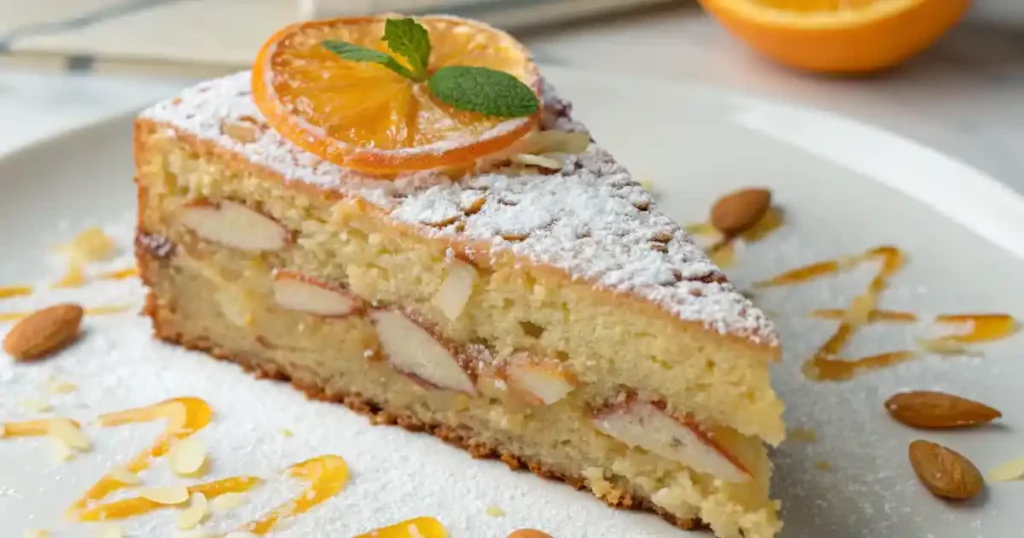Italian Orange Almond Cake: The first time I tasted pan d’arancio literally “orange bread,” though it is very much a cake was on a rainy afternoon in Palermo. A nonna at a neighborhood pasticceria slipped me a still‑warm slice, its aroma of sun‑ripened oranges rising like a promise of Sicilian summer. One bite and I understood why locals guard this recipe like family treasure: the crumb was unbelievably moist, the flavor equal parts sweet, zesty, and faintly bitter from the orange peel blended right into the batter.
Back home, I set out to recreate that experience while adding my own professional twists: a splash of Amaretto for depth, a touch of polenta for texture, and a glossy citrus‑honey glaze that keeps the cake tender for days. The result is an orange almond cake Italian enough to make a Sicilian nod in approval, yet unique enough to stand out in any search feed.
Table of Contents
Key Benefits
| Benefit | Why It Matters |
| Whole‑fruit nutrition | Using the entire orange peel, pith, pulp maximizes vitamin C, fiber, and essential oils for both health and flavor. |
| Naturally gluten‑optional | Almond flour supplies structure and richness; swap the small amount of wheat flour for fine polenta or rice flour to go 100 % gluten‑free. |
| Dairy‑free by design | Extra‑virgin olive oil replaces butter, giving a lighter crumb and heart healthy fats. |
| Minimal refined sugar | Honey and the fruit’s natural sugars allow you to cut granulated sugar by nearly half compared with many classic cakes. |
| Long shelf life | Almonds’ healthy fats and the honey glaze lock in moisture, so the cake stays tender for up to a week perfect for make‑ahead entertaining. |
Ingredients
Choose the freshest produce and highest‑quality pantry items you can find; in a cake with so few components, every flavor shines.
Core
- 2 small organic Sicilian oranges (thin‑skinned, about 450 g total)
- 200 g raw Marcona almonds, lightly toasted, cooled, then ground (or high‑fat blanched almond flour)
- 90 g fine polenta (or stone‑ground cornmeal for a rustic bite; use rice flour for GF)
- 3 large eggs, room temperature
- 100 ml fruity extra‑virgin olive oil
- 80 g acacia honey
- 60 g raw cane sugar
- 8 g baking powder (about 2 tsp)
- ½ tsp fine sea salt
Signature Enhancers
- 15 ml Amaretto (or Strega, Grand Marnier, or fresh orange liqueur)
- 1 tsp vanilla bean paste
- ¼ tsp freshly ground cardamom
Citrus‑Honey Glaze
- Juice of ½ orange (about 40 ml)
- 1 Tbsp wildflower honey
- 30 g icing sugar, sifted
Optional Garnish
- Toasted almond flakes
- Candied orange wheels

Instructions
Read through the recipe once, gather your mise en place, and bake with confidence.
1. Prep the Oranges
- Rinse and scrub oranges. Trim the stem ends.
- Place in a saucepan, cover with cold water, bring to a gentle boil. Simmer 15 minutes; this tames bitterness and softens the peel.
- Drain, cool to lukewarm, then quarter. Remove any seeds. Blend whole fruit (peel on) into a smooth purée. You need about 280 g purée.
2. Dry Mix
Whisk ground almonds, polenta, baking powder, salt, and cardamom until even.
3. Wet Mix
- In a separate bowl, beat eggs, sugar, and honey until pale and slightly foamy (3 minutes on medium).
- Stream in olive oil. Beat 30 seconds.
- Fold in orange purée, Amaretto, and vanilla.
4. Combine
Add dry mix in two additions, folding gently with a spatula. The batter will be thick yet pourable.
5. Bake
- Grease and line a 9‑inch springform with parchment.
- Pour the batter into the pan and tap it twice to remove any air bubbles.
- Bake at 170 °C / 340 °F (conventional) 35–40 min.A skewer inserted should come out with a few moist crumbs, not raw batter.
6. Glaze
While the cake cools 10 minutes in the pan, whisk orange juice, honey, and icing sugar until syrupy.Brush it over the warm cake and allow the excess to absorb for a shiny, glossy finish.
7. Cool & Serve
Release ring, slide cake onto a rack. Allow the cake to cool completely before slicing to achieve the cleanest crumb.

Pro Tips & Variations
- Flour swap: Replace polenta with equal‑weight hazelnut meal for a Piedmontese spin.
- Vegan route: Use 180 ml aquafaba whipped to soft peaks to replace eggs; add ½ tsp cream of tartar for stability. Increase bake time by 5 minutes.
- Chocolate twist: Fold in 60 g chopped 70 % dark chocolate just before baking think Torta Caprese all’arancia fusion citeturn0search5.
- Blood orange drama: When in season, swap one standard orange for a Moro blood orange to tint the crumb a delicate blush.
- Liqueur glaze: Substitute the orange juice in the glaze with a spoon of Limoncello for a grown‑up sheen.
- Low‑sugar adaptation: Drop cane sugar to 30 g and double the cardamom; the spice boosts perceived sweetness without extra calories.
Serving Suggestions
- Classic Italian: Dust with icing sugar, serve alongside a ristretto espresso.
- Dolce & Digestivo: Pair a slice with chilled Limoncello or Vin Santo to echo the almond notes.
- Gelato Upgrade: Top warm cake with a scoop of fior di latte gelato and a drizzle of the leftover glaze.
- Breakfast Treat: Toast a thin slice, smear with ricotta, scatter pomegranate arils for color.

Common Questions
Is Italian orange almond cake gluten‑free?
Traditionally, yes many nonne use only almond meal. This recipe contains a small polenta component for structure; swap with rice flour for 100 % GF.
How do you make an authentic Italian orange almond cake?
Authenticity hinges on two pillars: using a whole boiled orange for intense flavor and relying on almond flour rather than wheat for body. Follow the boiling‑and‑blend method outlined above citeturn0search4.
Can I use other citrus fruits?
Absolutely. Tangerines yield a sweeter profile, while Meyer lemons give a floral bite.Keep the total purée weight consistent to ensure proper moisture levels.
What is the origin of Italian orange almond cake?
Food historians trace pan d’arancio to Palermo’s Arab‑influenced culinary era, when citrus groves and almond cultivation flourished. The modern recipe likely emerged in 19th‑century Sicilian convents as a thrifty way to use whole fruit citeturn0search2.
Conclusion
An authentic Italian orange almond cake is more than a dessert; it’s a slice of Mediterranean sunshine, a testament to Sicilian ingenuity, and a masterclass in balancing bold flavors with simple technique. By boiling whole oranges, embracing almond flour, and finishing with a honeyed glaze, you create a cake that stays unbelievably moist and tastes better each passing day.
Ready to let your kitchen smell like a citrus grove? Gather those oranges, warm your oven, and bake this unforgettable pan d’arancio. When you do, share your results and personal tweaks in the comments every baker’s hand tells a new chapter in this cake’s storied journey. Buon appetito

Italian Orange Almond Cake (Pan d’Arancio)
Ingredients
Equipment
Method
- Step 1 – Prep the Oranges: Rinse, scrub, and trim oranges. Place in saucepan, cover with cold water, bring to a gentle boil, and simmer 15 minutes. Drain, cool, quarter, remove seeds, and purée the whole fruit (peel on). You need about 280 g purée.
- Step 2 – Dry Mix: Whisk ground almonds, polenta, baking powder, salt, and cardamom until even.
- Step 3 – Wet Mix: Beat eggs, sugar, and honey until pale and foamy (≈3 minutes). Stream in olive oil, then fold in orange purée, Amaretto, and vanilla.
- Step 4 – Combine: Add dry mixture in two additions, folding gently. Batter should be thick but pourable.
- Step 5 – Bake: Grease and line a 9-inch springform. Pour batter, tap pan twice to remove air. Bake 35–40 min at 170 °C / 340 °F until a skewer shows moist crumbs.
- Step 6 – Glaze: While cake cools 10 min, whisk orange juice, honey, and icing sugar. Brush over warm cake for a shiny finish.
- Step 7 – Cool & Serve: Release ring, cool completely on rack before slicing for a clean crumb.

